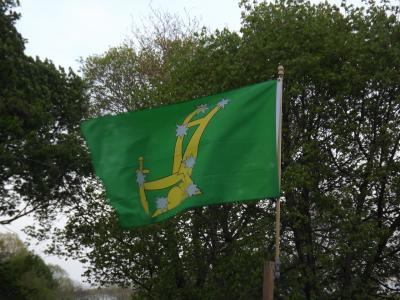May 19, 2016
 Starry Plough flagToday, I fly the “Starry Plough,” the flag of the Irish Citizen Army (ICA), in memory of James Connolly, executed by the British military 100 years ago, on May 12, 1916.
Starry Plough flagToday, I fly the “Starry Plough,” the flag of the Irish Citizen Army (ICA), in memory of James Connolly, executed by the British military 100 years ago, on May 12, 1916.
Connolly formed the ICA following the Dublin workers strike in 1913 that was suppressed by violent police attacks and an organized employer lock-out that eventually starved workers into submission and back to their poorly paid jobs. In 1916 Connolly, a visionary socialist, joined forces with the extreme nationalist secret inner circle of the Irish Republican Brotherhood in planning the Easter Rising.
Together, Connolly’s small socialist fighting force and the nationalistic and much more numerous Irish Volunteers seized buildings and other positions across Dublin on Easter Monday, April 24, 1916. Connolly brought to the enterprise military leadership (he commanded Republican forces in Dublin from rebel headquarters in the General Post Office) and a socialist idealism that was manifest in the Proclamation of the Irish Republic, which declared “the right of the people of Ireland to the ownership of Ireland.”
Republican forces held out for a week before British artillery fire forced their surrender. The Rising astonished people in Ireland. Initially, the insurgents were excoriated, especially by those with menfolk fighting for the British in the trenches of World War I. But as British firing squads began shooting rebel leaders, everything, to quote the famous lines of Yeats, “changed utterly.” People began to perceive British hypocrisy in sending thousands to the slaughter of the Great War “in defense of small nations,” while spurning Irish self-determination with contempt.
Almost overnight, 15 Irishmen, executed over an eleven-day period from the 3d to the 12th of May, became increasingly exalted as heroes and martyrs. This year, Ireland is commemorating the centenary of “1916” with pride as the pivotal event that led to political independence and redeemed a nation from the shame and humiliation of centuries-old political and cultural subjugation.
While the green, white, and orange tricolor and a green flag bearing, in gold, the words “Irish Republic” flew over the GPO, Connolly ordered the ICA to seize the Imperial Hotel directly across O’Connell Street and fly the Starry Plough from its roof. This was Connolly exacting revenge on behalf of Dublin workers. The owner of the Imperial Hotel was William Martin Murphy, a millionaire businessman who orchestrated the 1913 lock-out. Following the surrender, a young English soldier climbed to the roof of the hotel, pulled down the Starry Plough, and took it home as a souvenir. Forty years later he returned it to the Irish government for the 1956 commemorations. It is preserved today and on display in the National Museum of Ireland at Collins Barracks, a short walk from Arbour Hill where the remains of Connolly and the other men executed in Dublin rest in honored ground.
Connolly was last of the fifteen to be executed. With a serious leg wound from the battle, he was unable to walk or stand. The British soldiers shot him while he was strapped to a chair. Along with his comrades, he will continue to be honored and revered in Ireland and elsewhere by people who share his values. Still, many argue about whether and when his vision for economic equity and justice for all the people of Ireland – and indeed of the world – will be fulfilled.

